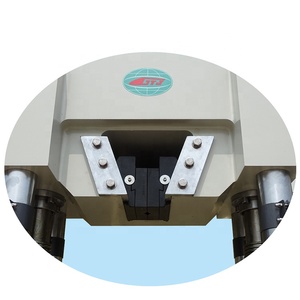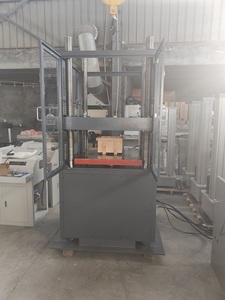(68 products available)












































































































































































Concrete flexural testing machines can be segregated into three categories depending on the mechanism used for load application. Here are the types of machines based on their operational modalities:
Mechanical Flexural Testing Machines
As the title suggests, mechanical machines offer the concrete flexural testing through screws, gears, and levers. These machines, operated manually or semi-automatically, are simple and lend themselves to infrequent use. They are often relatively cheaper and are mainly used in laboratories and educational institutions where low concrete flexural testing machine price is a deciding factor. The machines are suitable for testing small volumes of concrete. However, when high volume or speed of testing is required, mechanical machines are often inappropriate.
Hydraulic Flexural Testing Machines
Hydraulic machines apply load through hydraulic cylinders, ensuring uniform pressure. These machines, either manually operated or by pressure, are semi- and fully automated, making them ideal for large-volume testing. Thanks to the precise load application, hydraulic machines are desirable for commercial or large-scale regulatory testing. Although hydraulic concrete flexural testing machine has a relatively higher concrete flexural testing machine price, operational efficiency and accuracy make up for it.
Electromechanical Flexural Testing Machines
These machines are powered by electric motors through ball screws or other mechanical arrangements. They ensure accuracy and consistency in load application. Electromechanical machines are also relatively quieter than hydraulic machines. Flexural testing machines are suited to applications requiring high precision data such as research and development testing labs and institutions. They are, however, more expensive than mechanical and hydraulic machines.
Concrete flexural testing machines come with various specifications based on concrete types and flexural strength test requirements. These specifications determine the machine's suitability for a particular testing regimen.
Load Capacity
The load capacity depends on the application that a machine is put to. The capacity of common machines ranges from 10 kN to 1000 kN. Machines with higher load capacity are intended for testing high-strength concretes. The concrete flexural testing machine price typically varies with load capacity.
Loading Rate
Loading rates should preferably be configurable and should thereby conform to the relevant standards. Loading typically rates range from 0.5 N/mm² to 5 N/mm² per minute. However, this is in the case of normal loading; for special situations, the machine may have to be reconfigured.
Deformation Measurement
High-precision deformation measuring devices, such as LVDTs, improve test accuracy. Some electro-mechanical machines come fitted with internal deformation measurement devices. This removes the need for external measurement devices and hence makes the testing time faster.
Control System
Modern machines are moving towards Automation in the testing process. The software should therefore be user-friendly. Further, it interfaces with computers for data collection and analysis. Older machines lacked this feature and would often fail to test by hand. The newer generation machines have computers for control and data analysis. Sometimes, these machines interface with computers for data collection and analysis. This saves time.
Frame Construction
The frames of flexural testing machines are constructed in such a way as to ensure that they are rigid and reliable. Metallic walls provide strength and rigidity against load application. Hydraulically hollow frames are used to seal hydraulic cylinders and apply loads uniformly. Such frames are only used while conducting tests under special conditions. In machines with internal deformation measurement devices, the frame is designed with light materials, which provide strength to the frame and drive its internal components. Only the mechanical machines have light frames made of aluminum or other light alloys, which are easy to carry.
Standard Compliance
The machine must comply with international standards like ASTM, EN, or Indian Standards. Machines that meet these standards frequently undergo testing centers for concrete. Here, compliance ensures that the tests conducted are valid and widely accepted.
Accuracy and Precision
They are critical factors influencing the device's overall performance when testing machines. Mechanical machines usually lack precision, while hydraulic and electromechanical machines have it. However, hydraulic machines may be less precise if hydraulic fluid is not changed regularly or if there is an airlock. Precision is important in large-volume testing applications and research centers.
Ease of Use
Flexural testing machines should be easy to use, with controls that are easy to command and procedures that are easy to accomplish, often involving many tests. While electromechanical machines are very easy to use, hydraulic machines are not complicated but require extensive training before using machines to conduct concrete testing.
Cost-Benefit Balance
There are many types of concrete flexural testing machines, so one must know the concrete flexural testing machine price, especially when the price is a primary factor. It is important to know that higher prices machines are equipped with the latest technology, and although machines of lower prices are quite good, their technology is older. In cases where the testing volume is high, there is a need for more precision, or there are hours of operation to be considered, it is worthwhile to invest in a reasonably sturdy machine. Machines of lesser capacity might be justifiable for small operations or temporary works.
Estimating Mechanical Strength of Concrete
The basic property of concrete under construction is strength. Knowing the strength helps the users to know which materials can be used twenty years into the future. Thus, it is important to know the shape and thickness of a wheel on the vehicle and even to a layman, the flexural strength of the tube. Therefore, manufacturers conduct flexural strength tests using flexural testing machines to estimate the load sustainability of a new batch and, therefore, the type of work that should be practiced. In structures such as bridges, roads, and buildings, imperfect concrete can lead to monumental consequences.
Quality Control in Precast Concrete Production
Precast concrete structures are constructed with precast concrete assemblies at a controlled factory environment. For factory control of quality, the flexural testing machines work to ensure that each element has the minimum flexural strength designed so as not to cause failure in the field. Some examples of precast products are beams, hollow core slabs, and architectural panels. These products must possess adequate strength to sustain the loads they would be subjected to insite finally.
Assessment of Rehabilitation with Fibre Reinforced Concrete
Concrete does provide strength, but over time, and especially under adverse conditions, it loses this strength. For instance, if you were to use high-strength fibrous concrete for rehabilitation, it would be important to use a concrete flexural testing machine to test the strength of this concrete, especially when the project needs to use an impressive product. This test checks the flexural strength and, as a result, the ability of the rehabilitated concrete to bear loads. Infrastructure such as roads, pavements, and bridges, which show symptoms of wear and tear, need rehabilitation.
Research and Development in Construction Materials
Tests for flexural strength are valuable in innovation. They allow experiments with new mixes, such as chemical admixtures that improve the properties of concrete, or alternative fibres. R&D centers endeavor to discover the optimum concrete composition for tension and compression in anticipation of future trends in the industry with the concrete flexural testing machines at hand. They test recently learned and recommended techniques on prototype structures, thereby facilitating advances that lead to better design and construct methodologies. These prototypes are essential as they provide information about a proposed mix's performance, leading to safety and improved performance during real-life utilization.
Some of the frequently asked questions have answers that inform, amuse, or provoke thought. They are here to help fine-tune the mind and clarify doubts.
Q1: What is the function of a concrete flexural testing machine?
A1: This machine measures the flexural strength of concrete beams by applying a load until the beam bends or breaks.
Q2: Which three concrete flexural testing machine price are common?
A2: Mechanical (manual or semi-automatic), hydraulic (manual, semi, or fully automated), and electromechanical (automated) machines are common in the price and specifications of machines to test the flexural strength of concrete.
Q3: What factors should be considered while buying a concrete flexural testing machine?
A3: Machine Standard compliance, load capacity, precision, usage simplicity, and cost effect should be considered while buying concrete flexural testing machines and apparatuses.
Q4: Why is flexural strength vital in concrete constructions?
A4: Flexural strength determines concrete's ability to resist bending and cracking, which is crucial for the durability and structural integrity of buildings, roads, and bridges.
Q5: Why might hydraulic flexural testing machines be favored over others?
A5: Due to their efficiency when handling large volumes of tests and greater robustness in industrial contexts, hydraulic machines are preferred for commercial applications.